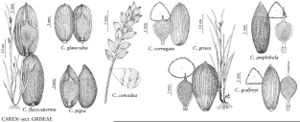Carex conoidea
Sp. Pl. 4(1): 280. 1805.
Plants densely cespitose; rhizome internodes 1.2–2.8 mm thick. Culms yellow-brown to dark brown at base, 2–75 cm. Leaves: sheaths glabrous; blades green, widest blades (2.3–)3–3.9(–5.6) mm wide, smooth abaxially or sparsely antrorsely scaberulous on main veins. Inflorescences (0.12–)0.21–0.91(–0.99) of culm height; peduncles of lateral spikes scaberulous; peduncles of terminal spikes 2.9–71(–103) mm, barely exceeded by to much exceeding lateral spikes; proximal bract sheath loose, abaxially glabrous, sheath front slightly convex, elongated 0.5–1.6 mm beyond apex; ligules 0.8–2.9(–3.7) mm; distal bract slightly shorter than to much exceeding terminal spike. Spikes (2–)3–6, widely separate or distal 2–4 overlapping or rarely all congested; lateral spikes pistillate, with (6–)18–37(–86) perigynia, 5–29 × 3.1–10.2 mm, ratio of spike length (in mm) to flower number = 0.51–0.95; terminal spikes (5–)8–26(–30) × 1–3.3(–4.2) mm. Pistillate scales 2.4–4.7 × 1.4–2.1 mm, margins red-brown to whitish, entire, apex with awn 0.2–2.7 mm or rarely awnless. Staminate scales (2.3–)2.9–4.5 × 1–1.6 mm. Anthers 1.8–3.6 mm. Perigynia spirally imbricate, 17–25-veined, unwrinkled, oblong-ovoid to oblong-obovoid, orbicular or suborbicular in cross section, (2.5–)2.8–3.6(–4.3) × (1.2–)1.3–1.7(–1.8) mm, (1.7–)1.9–2.5(–2.8) times as long as wide, lustrous, base very gradually tapered, apex gradually tapered; beak absent or straight, 0–0.2 mm. Achenes obovoid, 1.8–2.6 × (1–)1.2–1.4 mm, loosely enveloped by perigynia; stipe straight 0.1–0.3(–0.4) mm; beak straight, 0.2–0.4(–0.5) mm.
Phenology: Fruiting spring–summer.
Habitat: Moist meadows and prairies, shores of lakes, ponds, and rivers, usually in acidic sands or loams
Elevation: 10–1400 m
Distribution

Man., N.B., Nfld. and Labr., N.S., Ont., Que., Conn., Del., Ill., Ind., Iowa, Maine, Mass., Mich., Minn., Mo., N.H., N.J., N.Y., N.C., Ohio, Pa., R.I., Vt., Va., Wis.
Discussion
Carex conoidea is an uncommon plant throughout most of its wide range and is most frequent in New England. The species has been collected once in Arizona, where it is likely an introduction and does not appear to be persisting. Carex conoidea is unusual in Carex sect. Griseae in inhabiting open sites; it is the only species of the section regularly found in sunny habitats. Carex conoidea often grows with C. buxbaumii, C. tetanica, and C. pallescens.
Several previous authors have regarded Carex katahdinensis as distinct from C. conoidea. The name C. katahdinensis applies to dwarf plants of C. conoidea in the northern portions of its range. Carex conoidea exhibits clinal variation in several morphologic characters, including those used to recognize C. katahdinensis. Plants from higher latitudes are smaller in most features than plants from father south, but environmental factors also account for the morphology of plants matching the description of C. katahdinensis. Invariably, these plants have been collected from habitats with drastically fluctuating water levels, such as lake, pond, and river shores. The dwarfed morphology appears to be adaptive for rapid completion of the life cycle in such habitats.
Selected References
None.
